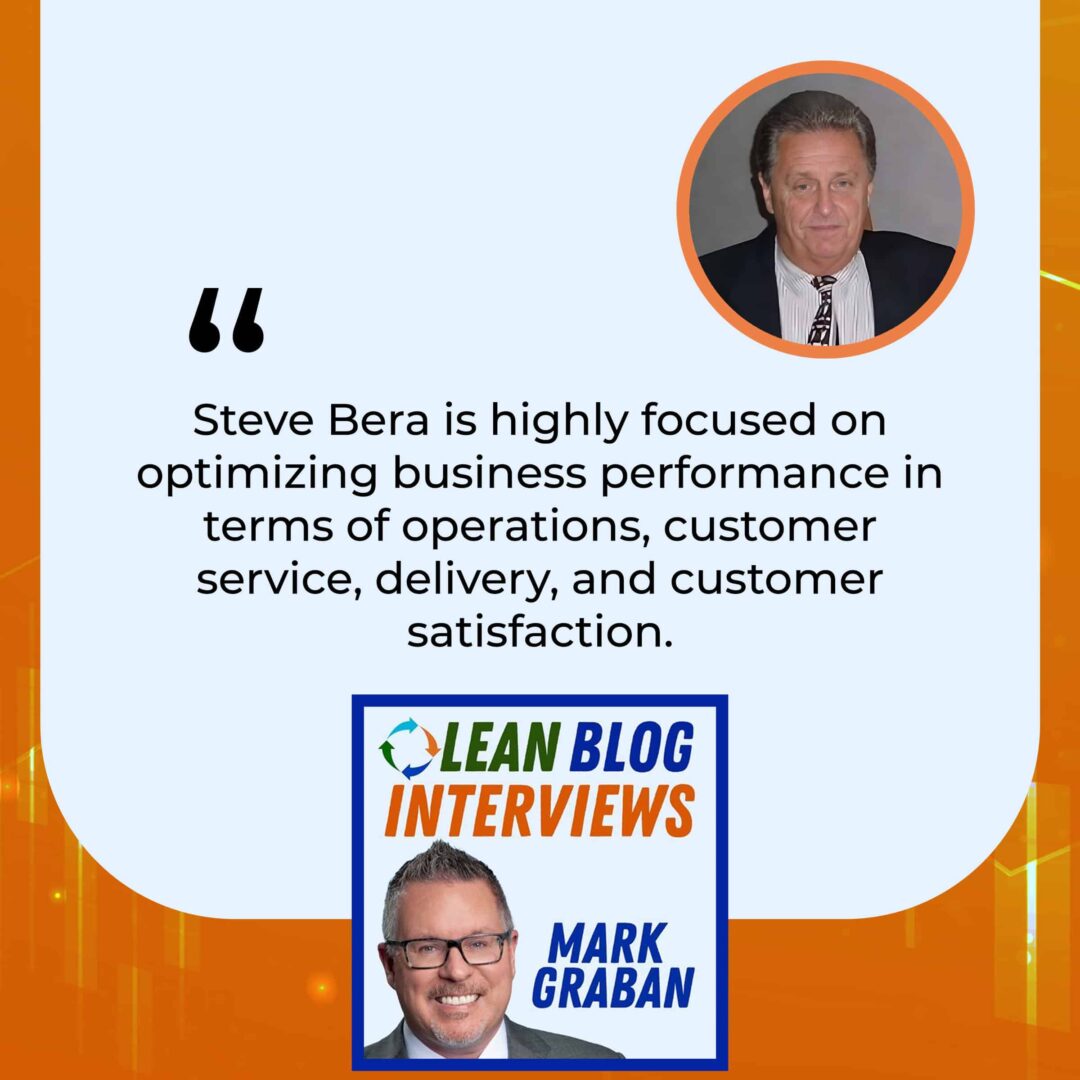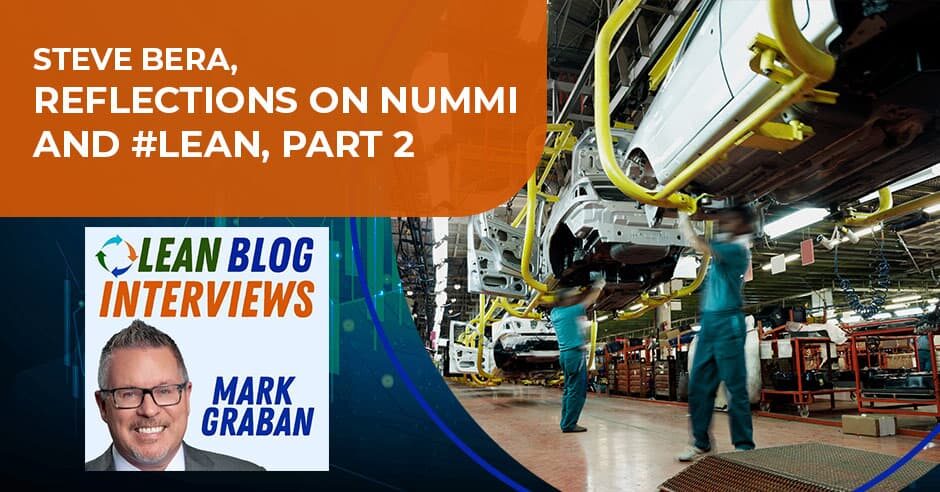Today's episode #259 is Part 2 of a discussion I started with Steve Bera in episode #256. Steve was one of the original 16 “NUMMI Commandos” that General Motors sent to work with Toyota in the 1980s, as discussed in the outstanding book Comeback: The Fall & Rise of the American Automobile Industry.
In Part 1, we talked about his experience at NUMMI. Today, we talk about what happened after his two years at NUMMI, why he feared getting lost back in the regular old GM, what he's done to teach and spread Lean in various industries over the past 30 years, and other thoughts on the current state of Lean.
A transcript of the discussion can be found at the bottom of the post. You can also read a summary I wrote of the two posts on LinkedIn.
Topics Covered In This Episode:
- The book describes the confusion about the lack of a “repatriation plan” – what happened? To you? At GM? Why was it hard to spread lessons back into GM?
- What have you done since leaving GM?
- How do you see the “state of Lean/TPS” in America? How much progress are we making?
- Do you have any experience working with healthcare or seeing the opportunity for Lean as a patient?
- What's the “risk” of a poorly executed Lean initiative?
For earlier episodes of my podcast, visit the main Podcast page, which includes information on how to subscribe via RSS, through Android apps, or via Apple Podcasts. You can also subscribe and listen via Stitcher.
Thanks for listening!
What do you think? Please scroll down (or click) to post a comment. Or please share the post with your thoughts on LinkedIn. Don't want to miss a post or podcast? Subscribe to get notified about posts via email daily or weekly.
Listen to the podcast here
Steve Bera, Reflections On NUMMI And #Lean, Part 2

This episode is part two of a discussion I started with Steve Bera back in Episode 256. Steve was one of the original sixteen so-called NUMMI Commandos that General Motors sent to go work with Toyota to learn from Toyota in the 1980s. As discussed in the outstanding book Comeback: The Fall & Rise of the American Automobile Industry, Steve and his story was featured in that book.
Back in part one, we talked about his experience in getting started at NUMMI and what he learned. We are going to talk about what happened after his two years at NUMMI, why he feared getting lost back at the regular old GM, what he did about that, and what he's done to teach and spread Lean in various industries over the past years. We will also talk a little bit about his thoughts on the state of Lean here in 2016. I hope you enjoy the episodes, both parts.
—
As NUMMI became a success story, maybe you can summarize some of that a little bit. The book, Comeback, describes some of the confusion about the lack of a repatriation plan for yourself and the other NUMMI commandos. How would you describe what happened a few years into the NUMMI experiment for you?
I can say this for all the rest of my partners who were the commandos. We had gone through a change, each one of us. A change in the way we felt a business needed to be run. The relationship management with each other, the team members, the union, and with our key executives. Toyota became the model for us to try to emulate somewhere else in General Motors.
Sixteen of us would get together on a regular basis, usually once a month, to talk about what we wanted to do with this experience when we finally have to go back into the corporation. We were unanimous in our thinking that we all wanted to go back to one facility. Whether that was one that needed a change because it was not a strong performer or a greenfield approach where we could build our own and have our own culture based upon the values that Toyota had given us.
Roger Smith and James McDonald would come out on a regular basis. We would sit in the room with them. They would ask from a pulse check, “How are we doing?” We all were so emphatic and positive about the experience, but we would also ask the question that when we were ready to go back into the corporation, we want to be able to have an impact upon General Motors.
Unfortunately, for the time that I was there, we could never get a concurrence out of anybody or any idea on what they wanted to do once our tours of duty were done. As time went on, that started to demoralize us because we were worried about the fact that we were going to be sent back as individuals as opposed to a team.
As my history showed, I didn't finish my tour because I was concerned about what I had heard. I didn't want my next twenty years in General Motors to be like the first twenty if I was not to get this opportunity to use that good experience. At this point is when I decided to go off in a different career direction.
What would you have anticipated if you were sent somewhere as a lone commando?
I would have been swallowed up by the local culture. I can tell you that not everyone had a chance to be a general manager at a facility. One of my very well-respected team members out there, Larry Spiegel, was able to be a general manager at one of the facilities. He developed the whole Toyota system.
I believe that he was probably one of the few who were very successful in being able to implement a lot of those concepts within the corporation. It put him in the number one chair. He was the man and I have always believed that it starts at the top. If it doesn't start there and cascade down, Larry in his career has always been one who would be the first one up front to talk about the value of what that Toyota experience did for him.
It starts at the top. If it doesn't start there, it doesn't cascade down. Share on XAs opposed to being sent in as the head of production control, you would have been swallowed up by the plant manager and the superintendent and all the prevailing ways of doing things.
That is correct. I didn't go back to General Motors after I left because I have been in so many corporations both domestically and overseas. I have seen those companies that have been successful in implementing Lean. It may not be the CEO or the COO, but in the companies that I worked with, we had the endorsement and support of those chairs. The mission was led by more of the senior vice president from the supply chain or the operations side.
I want to take a quick detour because you mentioned someone that I was very fortunate to work under and learn a lot from and that was Larry Spiegel. You had two years at NUMMI. I had two years at General Motors, but in my first year at GM in an engine plant in Michigan, we had the very traditional plant manager or management structure.
Somebody at Powertrain headquarters had decided, “We are going to hire people from these Japanese suppliers and Nissan.” We sent this group of 8 or 9 people to the Livonia engine plant. Maybe someone at Powertrain had thought that these were going to be some commandos to come in and help change.
That wasn't just one person. That was a group of people. They were completely swallowed up by the existing culture. They were quite literally exiled to these mezzanine offices that were in the far corner of the factory from the plant manager's office. The message was clear in many different ways. They were not welcome there and the existing plant management didn't know why they were there. They didn't want them. It was frustrating, but then after about a year, some fairly major quality problems, and productivity was terrible too, Larry was brought in as the plant manager, the man at the top. That set things on a very different path for the people working there in the future of that plant.
He was, in a good way, a zealot about this new approach and leading differently. The last thing and I will stop reminiscing. I traded emails with Larry a couple of years ago. I knew he was teaching at the University of Michigan. I asked him a question I'd never been able to ask before. The plant superintendent, the number two who was still there when Larry was brought in was the traditional yell, scream, and blame, and an old ogre of a manager. I asked Larry, “You seemed patient with him. Why did you tolerate a lot of that behavior and the way he kept acting?”
He said almost exactly what you said. “When I went to NUMMI, I had the chance to go through a change, and he never had the benefit of that.” I thought that was interesting. It made me a little bit more understanding or forgiving of why it was hard for the existing culture to change. Larry had a huge influence on me. It's hard to understate. I'm curious. Do you have any reactions to any of that?
You are spot on. Many of our organizations have legacy practices and we have people who have been around for many years. Maybe, in some cases, everything they have worked for has worked for them in the past. We are in a different world right now. Change is something that has to be more imminent as opposed to long-term planning.
Change is something that has to be more imminent as opposed to long-term planning. Share on XYears ago, people always ask the question. “What is your 5, 7, or 10-year plan?” There's no such thing as that anymore. The way that the business climate is both domestically and overseas, the influences are so strong. You have got to be able to do something in the next 24 or 36 months. Anything beyond that, you are going to come in 2nd, 3rd, or 4th, and you have got to be able to change. Now we have people who aren't accustomed to change. Change is the most difficult thing for all of us to go through and how do you do that? You are right. Whether without the NUMMI influence, without working with you or Larry, how do you get that individual? That's where mentoring comes in coaching.
I don't know if that's the adage about you can't teach an old dog new tricks. I don't subscribe to that to some people. There might be a percentage of those that will never change their habits or their spots and the way they manage. As I talked about humility, as long as you can accept and open up your kimono to understand what you are all about and where you have to change to go forward, you can change people, but they need mentoring and guidance.
I'm sure Larry was trying to coach that number two, but I'm sure that was a big challenge for him. You chose to leave NUMMI and General Motors. What happened after that? If you can summarize for people what some of those next steps were, what things you are able to accomplish with that experience of having gone through that change at NUMMI?
I was recruited out because, at that time, Toyota's involvement in influencing this country was in the embryonic stage of its history here. When I got recruited because I had now a newfound knowledge and knew some new experiences, maybe people thought we had the secret sauce and we probably did. We had something that no one else in this country did and that was a reason to be successful in understanding that we could carry that torch in that banner.
When I got recruited, I was involved in consulting and it was great to be able to go into companies that had never had an opportunity to talk about. Back then, many years ago, it was not Lean. It was more about TPS. We then had to transition away from TPS because of all the people who were upset about Toyota coming into the country. We had to transition into just-in-time, world-class manufacturing excellence. The one thing that is in Dr. Michael Hammer who was instrumental in the BPR for Business Process Re-engineering.
Everyone coined the TPS environment as something new, but when you read the books and you dissected it, for the most part, it's all the same. It's like any playbook. Playbook isn't as successful by itself. People have to pick it up and run according to what the playbook is all about. It's the hardest part, getting discipline and accountability for what the newfound disciplines are to run your business.
My challenge in consulting was to try to change people and companies. The most gratifying one I had was when I worked for three years with OfficeMax. I was brought in and I was the only consultant brought in and I was asked to help change the culture of OfficeMax. I spent three years full-time with these guys establishing an internal consulting group.
OfficeMax still has that same cadre of people. Some of them have gone on to other assignments or left a company. That same approach I had with Walgreens, I took the American Clip Company and I took to Walgreens. Those that want it, have a thirst for it and are willing to invest in it, it will change the way they run their business.
Were you getting to work with people who were at the top, whether that was a plant manager, division president, or CEO?
Everywhere that I went, part of my willingness to go in and help a company out was to work with a vice president level. It's the one who would be the sponsor. There are so many times that I would sit in front of the senior vice president, executive vice president, CEO, or president of the company, so they could hear and echo the same thoughts that I'm trying to expound upon through their organization. I had to be sure because they had to endorse it. They had to subscribe to it. Otherwise, people are going to, once again, feel like it's another false start and we couldn't afford to have that.
As you worked in other industries, especially as people in retailing, Walgreens, and Office Depot, you said.
I worked with American Clip Company, West Bend Company, and Bissell. I have worked with Harley-Davidson and it was not retailing.
As you worked with these different areas, how much did people hit you with the whole, “We don't build cars here,” as an objection? How do you work people past that if they want to point out, “Harley is different?” Walgreens, this is about health. It's not about building cars. What discussions did you have like that?
That's an excellent point. I had the fortunate career of being able to work in various industries. To carry out, from one to another, not so much the product, but the challenges that I faced. It became, “Was it a management issue? Was it a process problem?” The first question you asked when you are going into any company is, “What hurts?”
What are you trying to resolve by having whether it's a consultant or internally that your KPIs don't measure up to what you are trying to accomplish? I found that, invariably, it could be customer service or quality issues. It could be an absenteeism issue with people that then corresponded to other problems within the manufacturing sector.
You are right. Walgreens doesn't make a thing. Walgreens is a $72 billion company and all they do is have warehouses all over the country and their shelves are full of things. The problem that they were facing with is, “I can't keep the product on my shelves.” I went throughout because I had to establish a consulting team within Walgreens at each one of the DCs.
At the time we had 32 of them. It was to train everybody within each one of the DCs. I had a few people there at a corporate office who would accompany me on each one of those trips to where we'd give the training and every manager was involved in that. It was endorsed and supported by the general manager of each one of the DCs.
We never were lacking in terms of executive support and team member involvement because you can't pontificate a success story. You have to be able to demonstrate through your improvement activities whether you call it a continuous improvement or a reduction in quality issues. The problem that we faced was it was a common thread that existed with everybody and the process was broken.

The process was being administered by people and what we had to be able to do is to get some way to be able to administer the changing process. How do you do that? The kaizen work was outstanding because now you have people involved from every level in the organization to be able to identify and force rank some of the biggest problems you have to try to solve them.
If you go back to the books of Taiichi Ohno, he always said pretty clearly, “Start from need.” John Shook at the Lean Enterprise Institute talks about the need to identify what problem we are trying to solve. That seems like a far more effective starting point than saying, “We are going to go implement these Lean methods because, at some point, who cares?”
It's exactly right. I have been in organizations where when you walk out, you have all collateral from the standpoint of signage and sayings. They are all dressed up but they have achieved nothing. The key is to be able to understand, “What am I trying to solve here through the involvement of everybody?” and sustainability.
If I'm going to fix the problem, am I able to sustain it so there's no repeatability of that same issue later on? That's where you instill cultural change. The people are cognizant of the fact that I'm not making the same kinds of mistakes I did before. I'm coaching myself. I'm coaching those that are with me to be good at what we do.
Different organizations out there struggle with these different aspects of Lean and TPS. It might be hard to generalize. Here we are in 2016. How would you describe the state of Lean or the state of TPS in the US? How much progress are we making? What are the big challenges out there?
I'm still shocked over the fact that we are having to face some of these challenges in 2016 because the concepts, books, conventions, and conferences have been around for many years. When I first got to the GM building in 1979, we were already talking about some of the Japanese practices. I'm trying to understand how is it that we haven't been able to contemporize our practices after many years that we are still saying, “What are some of this Lean stuff? I have never heard of that. What do I have to do?” It's shocking that we don't have leaders who have tried to embrace it. Maybe they feel it's a threat. Maybe they feel that it's an investment that doesn't yield anything because they see it as more a window dressing as opposed to an execution of a change in the process.
I'm really still shocked over the fact that we're having to face some of these challenges today, in 2016, after 25 to 30 years. Share on XThey probably do see it as a threat. The one challenge and this is always a difficult discussion to have with people in healthcare when you talk about the need for culture change. Executives might at a high-level talk about it. “We want to change the culture.” How do you define the problem? What's broken with the existing culture?
People get far more uncomfortable with that discussion, and then there's the recognition. Especially in healthcare, you have a lot of organizations where someone has been the CEO of that hospital for 20 or 25 years. At some point, they start to say, “That reflects on me.” They don't want to talk about that. “Let's go do some projects. Let's train and certify more belts like that.” That's far less threatening than the reflection that comes with a discussion around, “How are we changing the way we manage?”
It's a thing because the healthcare industry has been one, particularly in the hospital side of the house. You can see it for every one of us that has experienced in a doctor's office. Maybe some time management issues don't seem to be prevalent in their practice. I have been in an emergency ward. I have walked through the hall to see other people.
The one thing that you have in a hospital is every person in that hospital is, for the most part, an independent business person. This nurse has this patient, these three patients, or whatever it might be. This person who does blood. This person does vital signs. In math, it's almost impossible to measure the effectiveness of the hospital when everybody is independent. If you have a hospital that's got 500 employees and they are all doing individual things, how do you assess the effect of that? That's the challenge in the healthcare industry. In the healthcare industry, if I'm a nurse and you are a patient, the best thing I can do is not have you need me, so I have dwell time.
As you and I have grown up with value-added versus non-value-added time, how do you put that in perspective when you are trying to measure the effectiveness, the utilization factor? There are two things. Efficiency and utilization. Those are two different things. In manufacturing, it's very easy to measure. In the hospital, I find that very difficult because utilization means that I'm on the clock. If I'm eight hours on the clock, how much time am I doing effective work? That is where the challenge is.

What you mentioned with the doctor's office and I get faced with this, a patient, what you described is a lack of time management. It's more of a fundamental assumption that goes back a long time in healthcare that says it's okay to make the patient wait. The focus is on keeping the doctor 100% utilized, which leads to poor flow.
There are some organizations that, through Lean and healthcare, are discovering that that's not right. It's not respectful to the patient for us to always be behind schedule. We need to improve our processes and flow and focus on that sometimes more so than the individual efficiency of individuals.
The one thing that I have never been asked in the medical profession is about customer satisfaction. If you go into multiple doctors' offices and I have been in there where I have seen 15 or 20 people sitting there in the waiting room. You will ask the question, “How are we doing in time? I'm here for my 9:00 appointment. How are we running?” “We are running about 45 minutes behind.” Ask me to fill out a customer survey at that point in time, but you typically don't get that because they are going to say that's the way their business is.
I blogged about this. I have never been once asked to do a simple plus delta at the end of an office visit. What went well? What could have been better? They never ask. I have complained to doctor's offices where I have been a patient. That doesn't lead to anything constructive. You are talking about the independent functions.
As hospitals are as siloed as anything in terms of functions and departments, but then you do have the unique complicating factor that more often than not, the doctors are not employees of the hospital. They are paid based on different criteria, and that criteria don't necessarily involve, even this is changing a little bit.
How do we keep people out of the hospital instead of treating them more efficiently once they are there? We will start wrapping up a little bit here. I appreciate you being so generous with your time here. There are still people who are very new to Lean. What advice do you have for them if they are getting started?
There are two pieces of it. The most important is if I'm all of a sudden in a chair or given the responsibility to implement Lean or if I'm somebody who's contracted to go help them, the first thing that I need to do or anybody else does, is to assess the organization's readiness for change. Is there a culture within that organization that will be receptive to change?
At that point in time, you have to talk about the changes that have taken place historically within an organization. Whether it's organization structure, personnel, movements, or whatever it might be. What are those challenges that they have faced in the past that they have been very effective at being able to manage? It comes down to who was responsible for the success of the change process.
You have to have that person who can carry that yardarm and leave that charge up the hill. I have always categorized, there are only two types of leaders in the world. One that orders to charge up the hill and one that leads the charge up the hill. An organization where somebody is going to lead that charge up the hill.
If you can look at the cultural readiness and the individual, you have an opportunity to be successful. At that point in time, then you can start laying the plan in place to be able to say, “What are we going to do?” The hard part is you can't change an organization that's got 1,000 or 10,000 people all at one time or whatever it might be.

It's like eating the elephant, one bite at a time, but where can you make the most impressionable impact upon an organization through change? You do that through a well-executed plan, through something that has been endorsed and approved by everyone in the organization from the top down, and then slowly start to make that change and use the success story as the one that will be the fodder for the next effort.
When you talk about leading that charge, I'm thinking back to earlier when you talked about not wanting to be the lone commando thrown into one of the other GM factories. I have talked to a lot of people in healthcare who had a great experience in manufacturing or, at this point, people who have experience with Lean and other healthcare organizations.
They get hired as a director of continuous improvement. A lot of times, you will hear the term lone wolf or lone commando and they struggle. Somehow their organizations have misunderstood to think, “If I hire that person, they are going to make me Lean.” It sounds like they are ordering the charge up the hill and they have appointed somebody who more often than not, it's not their fault as individuals. They are not the right person. They are not capable of leading that charge up the hill.
You would attest to this as well as anybody. If you are going to stand up in front of a group of senior executives, mid-level executives, or even a group of team members, what image are you going to project, and the first things that you say? Everybody is going to look at us with suspicion. It's like, “What can't you tell me or give me that I don't already know?”
The important thing is to establish some credibility immediately when we come out of the gate because you only get one chance to be successful at this. It has to be done with a lot of merits to what you bring to the organization and what changes, but you are also going to attest to the fact that you can't do it alone. You can have the best quarterback in the world, but if you have ten other guys that can't do it, I don't care. It is not going to work. You have to have a team and they are all going to play out of the same playbook.
Maybe as a final question here. There are a lot of things that could go wrong. What's the risk of a poorly executed Lean initiative? Is it that comment you made about you only getting one chance to be successful at this? Can you maybe elaborate more on those risks or some examples of what you have seen as a poorly executed Lean initiative?
If you are trying to mobilize or rally everyone around the flag, we have to be very careful that it's not perceived to be another fashionable start. Once you have something that people believe in and they subscribe to it, they all get behind it as long as the influence, leadership, and communication are done whereby people are seeing the change process.
The risk is if, all of a sudden, it is not embraced and not led by others, people will all of a sudden go back to, “I'm leaving my brains on the fence post outside. I'm coming in. I'm going to hit the clock at 6:00 in the morning. I'm leaving at 3:00, and I can care less about what goes on with the business as long as my job is protected.”
That's that whole annuity thing I talked about before. You are trying to build people that as pre-decor, and that's what a good Lean program does. It creates this pre-decor that everybody will pontificate the fact that, “This is good for us and we are doing very well. I'm comfortable about where my future is and where this company is going to be.”

What's the most common failure mode for these different Lean initiatives that struggle? Is that a factor of not having the right leader and not having the readiness to change at the organizational level?
An executable plan here, we can publish anything we want. We can hang banners. We can do whatever we want, but there has to be something that holds the team, the individual, and the organization accountable for this path that we are on. It has to have the ability to be able to do a pulse check every step of the way to be sure that we are on target. It is one of those things that I have always been comfortable with as far as being able to do the broadcasting, but I'm uncomfortable with the fact that too often, it's done as a publicity stunt or because it's a flavor of the day.
There's been a lot of that whether it was TQM, Six Sigma, and other methodologies. That's a big challenge in a lot of settings. People in healthcare, unfortunately, put their guard up. They hear about something new. I have had people quite literally after a short period of time where they start seeing the possibility with Lean. They are excited about being able to make things run better and they will ask, “How do we know our leadership is serious about it this time?” I'm like, “I can't guarantee that, but you need to talk to them about that.”
It's interesting that everywhere I have gone, they are dressed to the T and are highly respected on every word that comes out of their mouth, but it's more of an image as opposed to one who can demonstrate leadership. The leader has to be the one who has to have visibility within the organization, whether it's the communication process through monthly sessions with the teams, show, videotape, or anything. The leader, no matter what level, has to be recognized as the one behind this. It's not something that's arbitrary. It's mandatory.
Steve, thank you so much for taking the time to have a great discussion here on a two-part episode. I appreciate you sharing your experiences and reflections. Do you have any final thoughts that you might want to leave the readers with?
I am asking myself this question even now. If it's not Lean, what should it be? What's next? What's in our toolkit? It doesn't matter whether your healthcare, manufacturing, or high tech, but what have you got in your toolkit that you can take out that's going to ensure that you have optimized business performance in terms of operations, customer service, delivery, and customer satisfaction?
If it's not #Lean, what should it be? What's next, or what's in our tool kit? Share on XThat's a great question because for those in healthcare who say Lean, those who still want to make the argument Lean does not apply to healthcare. What do they propose other than more of the same, more money, and things that we don't have here in the US or in other countries? People tuning in to the show probably self-selecting groups of believing that Lean is that way regardless of their setting, but I would love to hear from people if they know how others would maybe answer that question. Our guest here has been Steve Bera. Thank you so much for being with us here.
Thanks.
Important Links
What do you think? Please scroll down (or click) to post a comment. Or please share the post with your thoughts on LinkedIn – and follow me or connect with me there.
Did you like this post? Make sure you don't miss a post or podcast — Subscribe to get notified about posts via email daily or weekly.
Check out my latest book, The Mistakes That Make Us: Cultivating a Culture of Learning and Innovation:











